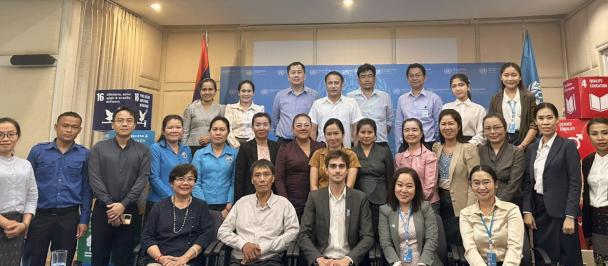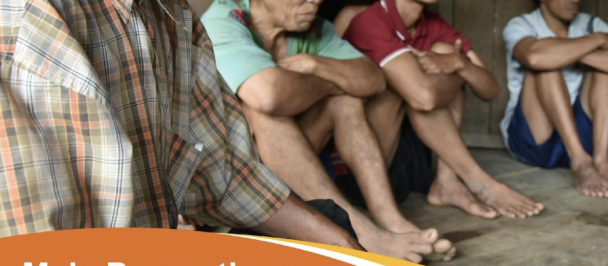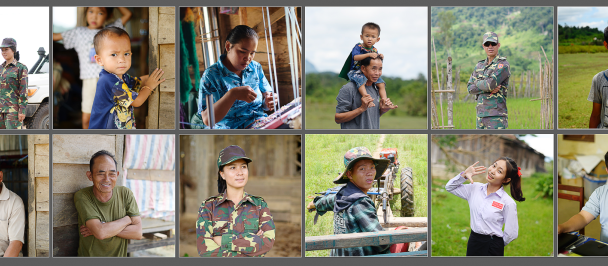Photo by: UNDP Lao PDR
We had arrived just half an hour before the launching ceremony of the National Eld’s Deer Sanctuary. There were exhibition booths surrounding the main event area where seats were arranged for distinguished guests and visitors.
Savannakhet Province, where the event was taking place, is well-known for its cotton “Sinh” or Lao skirt and fabric. They’re recognized for their unique blue and white colour- patterns. It was definitely a souvenir I planned to take home.
There was a stall, selling the most unique cotton Sinhs. A young and rather shy man stood behind the pile of fabric. I thought he was just standing in to look after it for his family, as it is rare to see men sell Sinhs. I initially thought to myself, “Should I wait for the owner to come back?” But I decided to just approach him to see if the products were local.
The fabrics were hand-woven by women in Alahng district, he seemed to know the origin. So, I continued to inquire if he was selling with a partner. He said, he was the only owner.
Sayfon Sayalard, 27, said he was originally a vegetable farmer who also foraged for wild mushrooms, found in the sanctuary. In recent years, due to changes in weather and the lack of rain, there hadn’t been much to harvest, especially this year. In past years, there would’ve been at least a small pick-up truck worth of harvest and they fetched a decent price. Besides mushrooms, in other seasons he’d grow different vegetables. The seasonal changes over the past few years had caused several economic challenges for him, which forced him to find other means to earn a living.
Women farmers near where Sayfon lived, have turned to weaving cotton sinh, to help make ends meet. The Sinhs were piling up at the womens’ homes because of the lockdown. People were not allowed to commute between villages without authorization. And since those who used to help bring their products out to the markets were not local to the area, these women had neither the means of marketing their products, nor the logistics to deliver.
So, Sayfon decided to negotiate with them by volunteering to bring their products to sell at events or fairs, including exhibitions. The women accepted his offer.
“I was planning to bring these fabrics to Vientiane just a few months ago to sell at the cultural events. But the cases of COVID-19 were confirmed, and lockdown measures were in place. I needed permission to leave my compound,” said Sayfon. “It was especially difficult as we could almost make nothing given those circumstances and there was no way to sell anything.” The exhibition at the sanctuary was the first opportunity to showcase the products, for which he charges 50,000 Lao Kip or about US $6.00 per piece.
I bought one, but what stayed with me was how I had unintentionally stereotyped Sayfon, as I didn’t think a man would be selling Sinh, or know much about it.
I was impressed that he was willing to support women and how they had worked together to empower the community. It was another lesson in hope and collaboration - if you are willing to seek opportunity, the answer can sometimes be right in front of you, within your own community.
This was not what I expected my new skirt to bring me, the story behind an affordable and beautiful piece of fabric that impacts more than one life. This skirt I own may not be the most expensive, but its story is invaluable to me.
Written by:
Ms. Aksonethip Somvorachit, Communications Analyst, UNDP Lao PDR.
The views expressed in this article are those of the authors alone and not the United Nations Development Programme.
--------------------------------------
For more information about the SAFE Ecosystems project, please contact:
Mr. Keophouvong Chanthapanya
Project Manager of the SAFE Ecosystems project
Department of Forestry, Vientiane, Lao PDR
Email: ckeophouvong@yahoo.com
Tel: 020 98 077 717
Mr. Adam Starr
Chief Technical Officer of the SAFE Ecosystems project
Department of Forestry, Vientiane, Lao PDR
Email: adam.starr@undp.org
Watch our video below learn more about the launch of the National Eld's Deer Sanctuary:

 Locations
Locations



